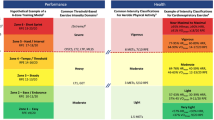Summary
The individual anaerobic threshold (IAT) has been defined as the highest metabolic rate at which blood lactate (La) concentrations are maintained at a steady state during prolonged exercise. The validity of this definition, however, has not been substantiated. Eleven men [maximum oxygen uptake (\(\dot VO_{2max} \)), mean (SD), 57.8 (6.9) ml·kg−1 · min−1) did two maximal incremental cycle exercise tests (30 W and 4 min per step). Blood was sampled repeatedly during exercise and for 9 min during the subsequent recovery period with light activity. The subjects then exercised at the power output equivalent of IAT for 45 min, until they could no longer continue or until rectal temperature reached 39°C. Subjects performed two additional exercise tests. The intensity of these tests depended upon the LA and acid-base responses during the last 15 min of at least 30 min of exercise at IAT. If a steady state was achieved (La, pH and PCO2 changed by less than 0.5 mmol·l−1, 0.005 pH units and 0.3 kPa, respectively) or decreasing La and increasing pH values were observed, then the second test was performed at IAT + 5% \(\dot VO_{2max} \) and the third session at either IAT + 2.5% or +7.5% \(\dot VO_{2max} \). Conversely if a steady state was not achieved during exercise at the calculated IAT, the intensity of the second test was set at IAT−5% \(\dot VO_{2max} \). Depending on the La and acid-base responses during this test, the final session was performed at either IAT −2.5% or −7.5% \(\dot VO_{2max} \). Test-retest reliability for the determination of IAT was high (r = 0.98; estimated SE was 8 W or about 2% \(\dot VO_{2max} \)) and the method was reproducible [mean (SD); 240.3 (41.7) W for test 1 and 236.6 (42.9) W for test 2]. However, only 4 subjects completed at least 30 min of exercise at IAT with steady-state La and acid-base responses. None of these subjects showed steady-state responses at +5% \(\dot VO_{2max} \) above IAT, and only 1 met the criteria at +2.5% \(\dot VO_{2max} \) above IAT. Therefore, for these individuals the incremental exercise test underestimated the “true” IAT by less than 5% \(\dot VO_{2max} \). For the other 7 subjects, 4 met the steady-state criteria at both −5% and −2.5% \(\dot VO_{2max} \) below the calculated IAT, suggesting the true IAT was overestimated by less than 2.5% \(\dot VO_{2max} \). For 2 of the remaining subjects, the incremental exercise test over-estimated the true IAT by at least 7.5% \(\dot VO_{2max} \). Therefore, the maximal incremental exercise test followed by a light active recovery period will produce a reliable and reproducible estimate of IAT which is valid for the majority of subjects. However, since the method overestimates the true IAT for some individuals, the procedure cannot be assumed (without verification) to be valid for all subjects.
Similar content being viewed by others
References
Buono MJ, Yeager JE (1986) Intraerythrocyte and plasma lactate concentrations during exercise in humans. Eur J Appl Physiol 55:326–329
Harris RT, Dudley GA (1989) Exercise alters the distribution of ammonia and lactate in blood. J Appl Physiol 66:313–317
Haverty M, Kenney WL, Hodgson JL (1988) Lactate and gas exchange responses to incremental and steady state running. Br J Sports Med 22:51–54
Jacobs I, Keith S, McLellan TM (1990) A range of intensities elicits the individual anaerobic threshold (abstract). Med Sci Sports Exerc [Suppl] 22:S56
Keith S, Jacobs I, McLellan TM (1992) Adaptations to training at the individual anaerobic threshold. Eur J Appl Physiol 65:316–323
MacRae HS-H, Dennis Sc, Bosch AN, Noakes TD (1992) Effects of training on lactate production and removal during progressive exercise in humans. J Appl Physiol 72:1649–1656
Mazzeo RS, Brooks GA, Schoeller DA, Budinger T (1986) Disposal of 13C lactate in humans during rest and exercise. J Appl Physiol 60:232–241
McKelvie RS, Lindinger MI, Heigenhauser GJF, Jones NL (1991) Contribution of erythrocytes to the control of the electrolyte changes of exercise. Can J Physiol Pharmacol 69:984–993
McLellan TM, Jacobs I (1989) Active recovery, endurance training, and the calulation of the individual anaerobic threshold. Med Sci Sports Exerc 21:586–592
McLellan TM, Cheung KSY, Jacobs I (1991) Incremental test protocol, recovery mode and the individual anaerobic threshold. In J Sports Med 12:190–195
McLellan TM, Cheung KSY (1992) A comparative evaluation of the individual anaerobic threshold and the critical power. Med Sci Sports Exerc 24:543–550
Mocellin R, Heusgen M, Gildein HP (1991) Anaerobic threshold and maximal steady-state blood lactate in prepubertal boys. Eur J Appl Physiol 62:56–60
Orok CJ, Hughson RL, Green HJ, Thomson JA (1989) Blood lactate responses in incremental exercise as predictors of constant load performance. Eur J Appl Physiol 59:262–267
Stanley WC, Gertz EW, Wisneski JA, Morris DL, Neese RA, Brooks GA (1985) Systemic lactate kinetics during graded exercise in man. Am J Physiol 249:E595-E602
Stegmann H, Kindermann W, Schnabel A (1981) Lactate kinetics and individual anaerobic threshold. Int J Sports Med 2:160–165
Stegmann H, Kindermann W (1982) Comparison of prolonged exercise tests at the individual anaerobic threshold and the fixed anaerobic threshold of 4 mmol · l−1 lactate. Int J Sports Med 3:105–110
Author information
Authors and Affiliations
Rights and permissions
About this article
Cite this article
McLellan, T.M., Jacobs, I. Reliability, reproducibility and validity of the individual anaerobic threshold. Europ. J. Appl. Physiol. 67, 125–131 (1993). https://doi.org/10.1007/BF00376655
Accepted:
Issue Date:
DOI: https://doi.org/10.1007/BF00376655




